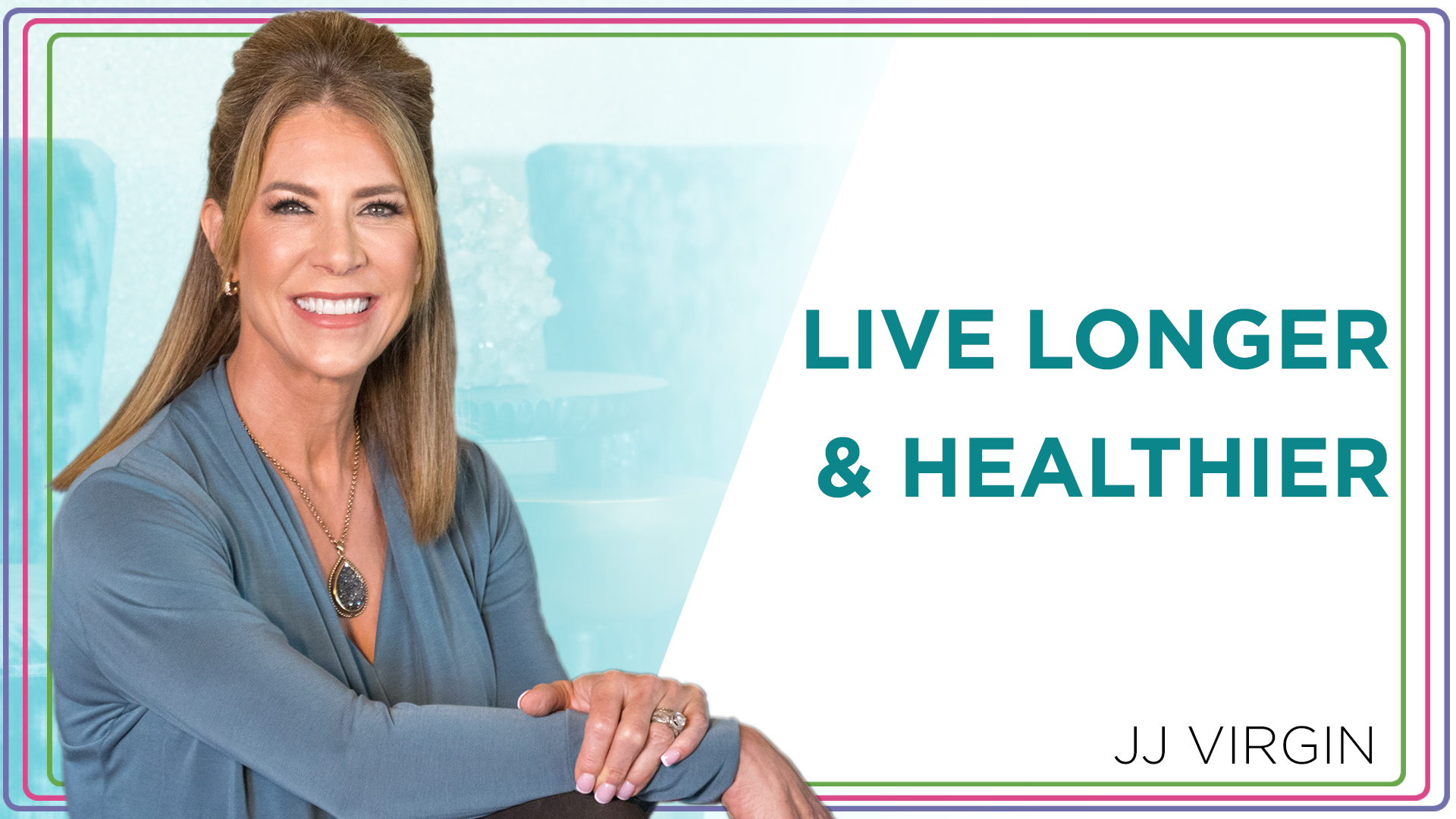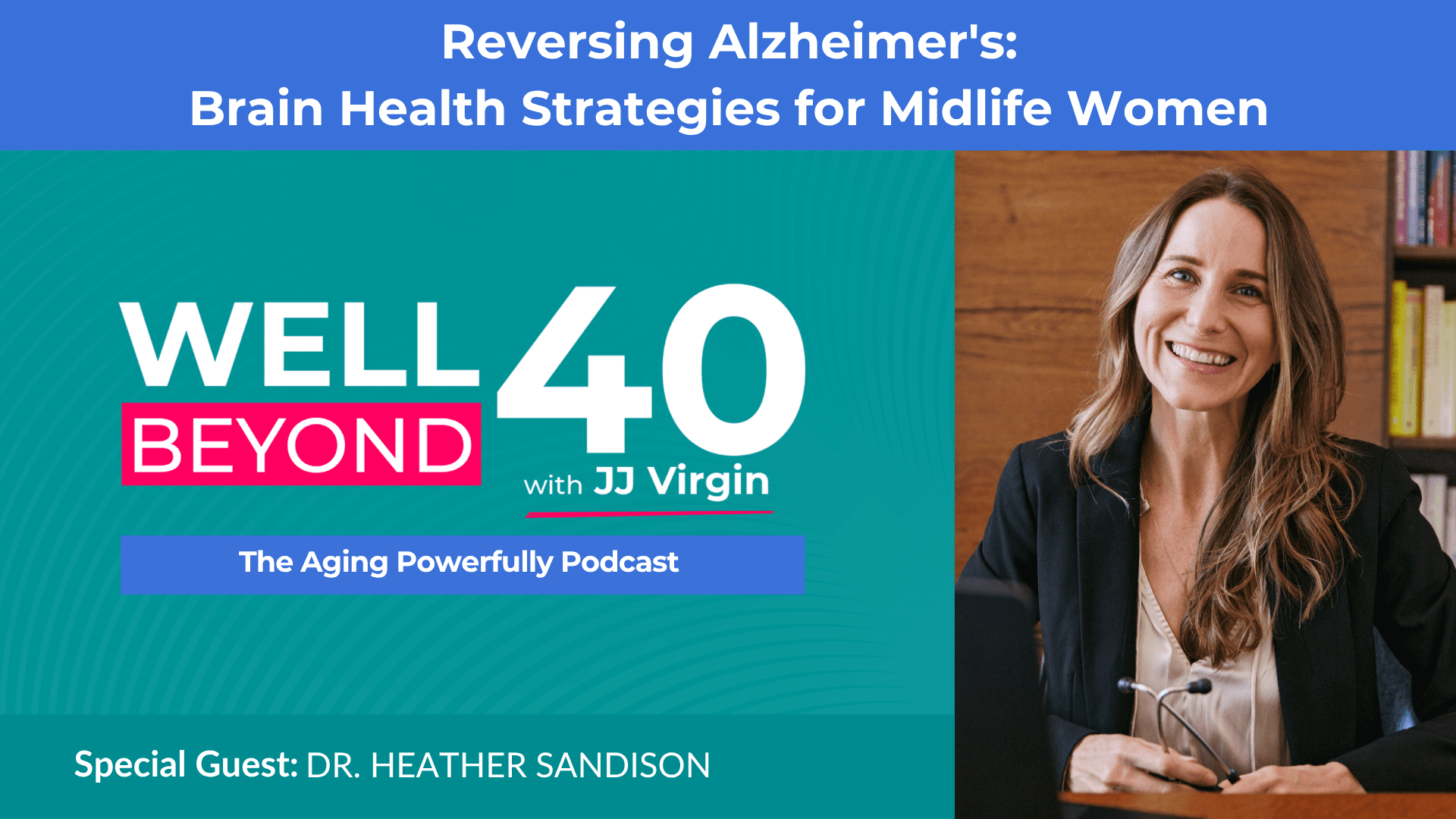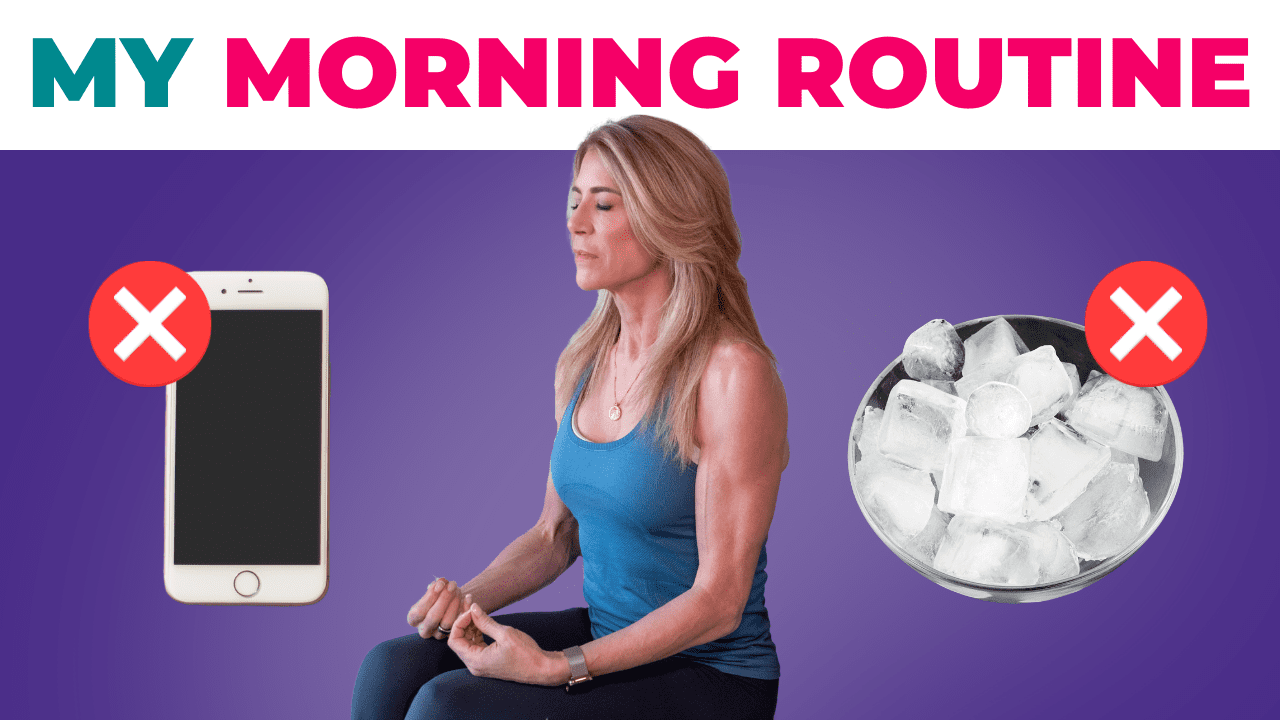Use this Simple Secret from the Blue Zones® to Burn Calories & Live Longer
The Blue Zones® are the 5 places throughout the world where people live the longest, healthiest lives. They share similar habits: People in those 5 areas manage stress well, eat a mostly plant-based diet, and stay active and lean into their senior years. I discovered a simple Blue Zones® secret that you can implement to get healthier and live longer. Here, I’ll show you how Blue Zones® folks move more (hint: it doesn’t involve hours in the gym), why the number of calories you burn on the treadmill isn’t accurate, the NEAT way to burn calories (and why this is a game-changer), how fidgeting might be the secret to burning more calories, plus easy ways to move more throughout your day for longevity and living healthier.
Mentioned in this episode:
ATHE_Transcript_Ep 422_YT 15
JJ Virgin: [00:00:00] What if it turns out that there was a really simple way to hack your metabolism and burn fat, almost effortlessly. And maybe even live longer. Well, turns out there might be, and it’s based on some pretty cool new science. Hey, it’s JJ. Now, if you want to keep up with the latest research on things that will help you get healthy and then bonus lose weight too make sure you don’t miss out, hit like, and subscribe to this channel.
And you’ll be good to go. If you’ve heard of the blue zones, you know, that people living in those five places are living a lot longer than just about everybody else. Sometimes past a hundred. And more importantly, they’re healthy too, because who wants to live to a hundred unhealthy right now, even though they’re spread out around the world, they have pretty much the same lifestyle habits.
And there’s some surprising things. In fact, one surprising thing that they do that you can easily do too, no matter where you live. If you want to get healthy, feel better and lose weight too. You [00:01:00] probably already know that being overweight can put you at risk for disease, and it can also decrease your life expectancy and the quality of your.
So, if you want to avoid that, it makes sense to look for examples of people who seem to have cracked the code, like the people who live in the blue zones, they’re active and lean way into their senior years. It’s the closest thing anyone has come to to discovering the fountain of youth? I think so.
What’s their. Well first, if you don’t know, the blue zones are five areas around the world where people live the longest and healthiest well into their old age, and like, listen to these ones because you’ll go, huh? It’s Okinawa, Japan, then Sardinia, Italy. Then Nicoya in Costa Rica, then Ikaria in Greece.
And then I find this one, the craziest Loma, Linda, California. Now they might seem like they got nothing in common, but they actually have a lot of things in common things [00:02:00] that seem to be the key to their health and long lives. And here’s, what’s interesting. It’s not just diet and exercise. It’s also things like having a sense of purpose and minimizing stress and yes, of course, I’m going to talk diet and exercise because that is of course a piece of it.
Now they eat mostly a plant-based diet and by the way, They eat real food. Right. And they do something active every single day. And of course that makes sense because you always hear diet and exercise are important to your health and to losing weight. And that’s true. But the people in the blue zones, aren’t exactly killing it at the gym.
In fact, like most of those places don’t have gyms, right. So what are they doing instead to stay active? What they’re doing every day to stay active is actually really simple. Are you ready for. It’s a big secret. They move. Yep. They just move. [00:03:00] But here’s the key. They move all throughout the day. They’re doing the smaller things that constantly keep them moving.
They’re taking the stairs, they’re walking the Hills, they’re parking farther away. You know, those things we always tell people to do that. No one does. Now, these things aren’t exactly hard. But clearly there’s something to this because these people are by and large, healthy and lean and living longer. And it’s not from working out.
They know what most people don’t, and that’s that exercise doesn’t really burn the calories or take off the pounds. You think it does, you know, I’ll tell you early on when I was a personal. I remember people were coming to me to lose weight and they go, I don’t want to change my diet. I just want to exercise to lose weight.
And I found out really, really quickly that you could not out exercise a poor diet and that you couldn’t just go to the gym for a little bit each day and it would make this big substantial difference. [00:04:00] Here’s why when it comes to weight loss, people usually overestimate the benefits of exercise and especially intense exercise.
You know, when you go to the gym and you’re, there sweating it out on the treadmill and then you’re done and you’re all excited and you see the readout of how many calories you burned on that treadmill. And you’re feeling really good about it. I don’t want to be a buzzkill, but I’m going to be a buzzkill because that is not actually an accurate measurement.
And here’s why you’ll see, oh, you burned 300 calories or 400 calories, but that is not true because that measurement doesn’t take into account the calories. You would have burned if you hadn’t done that in the first place, your resting metabolic rate. So it over exaggerates the amount of calories that you’re actually.
It doesn’t take that out. Leaving out your resting metabolic rate is a huge miss and really skews the results. Your resting metabolic rate is that metabolic rate. You need to maintain your vital functions like breathing and keeping your heart beating, [00:05:00] or, you know, when you’re just resting or hanging out.
And usually it’s when you’re just sleeping, you’re comfortable, et cetera. It’s not like when you’re freezing, by the way or shivering, that will change your metabolic rate. But the thing is those machines, the gym, they are not calculating that for you. They don’t calculate how many calories you would have burned at rest, just living and breathing and then subtract that out.
But they should, right. They should, it would make more sense because those resting metabolic rate calories are going to be burned no matter what. And they count. I mean, they’re actually your biggest part of what you’re burning every single day. So they have to be subtracted from that equation in order to know how many calories you’re burning, just from the workout alone.
So that’s why people always overestimate the amount of calories they’re burning when they do exercise. So. First of all, you know, me, your body’s not a bank account. It’s a chemistry lab. I want you to give up this whole obsession on the calories, on how many calories you’ve burned working out, because, A: you’re never going to know the [00:06:00] accurate number anyway, and there’s a way better way to look at exercise for the real value.
It gives you in terms of your overall health. It’s not the calories burned, right? It’s what it’s going to do for your brain. It’s when, what it’s going to do for building muscle it’s, what’s going to do for insulin sensitivity and stress management. The real value is the metabolic impact you get from the muscle in terms of, from the exercise, again, is all of those things.
That’s what you want to look at, and that can’t be quantified into how many calories you burned at a workout. It’s how much muscle did you put on? That’s going to change your metabolic rate all day long, how much more insulin sensitive and glucose tolerant did you get? Now did you teach your body how to handle stress better?
Right. So many more important things. So let’s just release the calorie thing, all right. Back to the blue zones and how much they move. It’s one of the biggest factors in their longevity, but it’s something most people overlook in [00:07:00] their lives every single day. And bonus. It is so easy to do. And again, I’m not just talking exercise here.
I’m talking, just moving, moving activates something called neat and neat stands for non exercise activity, thermogenesis. It’s that energy that you burn doing everything except exercise or sports. Now we just talked about the fact that you’re also going to burn calories, whether you move or not because of your resting metabolic rate.
So if you take, we’re going to do a little math here, but when you take RMR your resting metabolic rate, that’s how many calories you would burn if you’re just hanging out, but you’re not doing things like shivering. And meet. Those are two ways you burn. But they’re not the only ones. The third is the calories you burn through eating, which is called the thermic effect of food.
Now I covered that in detail in another video, but the highlight here is that it’s basically the energy it takes for you to digest your food and [00:08:00] absorb nutrients for. Protein has a high thermic effect because it takes more energy to digest than carbs. So eating more protein and fewer carbs can help with weight loss and can have a better effect on your metabolism.
Okay. Number four is of course the calories you burn from exercise, but if the four ways you burn energy every single day, your resting metabolic rate, neat, the thermic effect of food and exercise. The math on where you’re burning the most calories may surprise you, your resting metabolic rate accounts for approximately 70% of your total energy expenditure every day.
Neat represents about 15%. The thermic effect of food represents about 10%. So let’s do the math exercise represents approximately 5%. 5%. Come on. So there you go. The energy you burn [00:09:00] from exercise is the lowest percentage of your daily total. The highest is your resting metabolic rate next followed by neat.
That’s a big aha, right? The calories you burn through neat are a game changer and it’s a big part of what’s going on in the blue zones. So it’s time to get moving. But just know that your mileage may vary because neat. Isn’t the same for everybody. It increases the more you move. So the more, the better, and here’s the cool thing.
That means, you know, you see you, you’ve heard that that sitting is like smoking cigarettes. So you want to stand as much as possible. You want to fidget as much as possible. You want to get a little cold as much as possible. All of these things are neat. There was one study that measured neat and lean and obese people who are all sedentary and had similar jobs.
The obese people sat about two and a half hours more. The lean people, the leaner folks stood up or walked around over two hours more each day, two hours more each day. [00:10:00] So what we’re learning is that fidgety people, right? If you’re a fidgeter, you could burn 800 to 2,500 more calories a day than someone who’s like sitting still kind of look at all those teachers who told you to sit still like.
Damage I could have done. You tell your kids to ignore them, right? You tell your kids to fidget and look, I know you already know you should park your car farther away from target, but you never do it. Do you? I mean, if that was the case, there’d be lots of spaces at the front and there never are. So we know no one’s doing it, but maybe now you will.
Now that you know, that more movement will activate your knee. You’ll rethink where you park because the little things do matter. And by the way, I’ve got an office upstairs in my house and the kitchen and everything else is downstairs. I was going to get a little refrigerator and a coffee maker up here, and I thought, no, you are not going to do that.
You’re going to go up and down the stairs up and down the [00:11:00] stairs, up and down the stairs. Then I’ll tell you another little story. My little doggy, my six pound dog, Daisy. What, when I was traveling a lot was living with my ex-husband, who may have overfed her a little and I got her back and she was 10 pounds.
She is supposed to be six pounds. So that was quite a weight gain. And one of the things I just did was have her moving a lot more. I had her, we were living in a house with stairs, we just moved into it. She followed me up and down and up and down and up and down all over the place. And we did that with some intermittent fasting and boom got the weight off her pretty quickly.
So do not underestimate all of the little things that you can do every single day to activate your. All right. Ask yourself, Hey, how can I incorporate more movement into my life? Can I do my conference calls standing up instead of sitting down? Can I work from a stand-up desk? Can I read that article while I’m walking on a treadmill?
Can I do my meetings and conference calls while I’m out and about? Can I listen to that podcast or seminar while I’m [00:12:00] moving or doing some gardening? Or here’s one. How about, can I use a regular old push vacuum cleaner? Remember those, make this, your new rule. If someone calls to ask what you’re doing while your Roomba is running, you’re not allowed to answer that you’re vacuuming.
That doesn’t count. All right. Obviously activating your knee will be unique to you and what your day is like and where you live. But bottom line is, it will pay huge dividends. So find a way each day to make the simple change in incorporating, moving more, even fidgeting into your life because it’s going to make a big difference in your health and your weight and how you feel.
Now, if you’ve enjoyed this video, please let me know by hitting like, and subscribe to stay in, touch up next. Check out my video on five things you’re going to want to do to make the transition to menopause. [00:13:00] As easy and painless as possible. See you there
for more info on this and other health topics I cover or to rate and review, find me on Instagram, Facebook and my website, JJvirgin.com. And don’t forget to subscribe to my show. So you won’t miss a single episode? Go to subscribetojj.com. Thanks again for being with me this week. .

 Subscribe to our show
Subscribe to our show 




